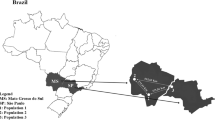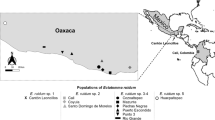Abstract
Colonies ofReticulitermes flavipes andR. santonensis were collected from the southeastern United States (Georgia) and the southwest of France (Charente-maritime). Defensive compounds and cuticular hydrocarbons were identified by gas chromatography-mass spectrometry and quantified by gas chromatography using an internal standard for each caste and all colonies. These analyses show that although the cuticular hydrocarbons ofR. santonensis in Europe andR. flavipes in Georgia are identical, their relative proportions are different. However, the defensive compounds synthesized by their soldiers are different. A strong chemical polymorphism between sympatric colonies ofR. flavipes in the SW United States was detected in terms of both the hydrocarbons of the workers and soldiers and in the defensive secretions of the soldiers. The six defensive secretion phenotypes are based on the presence or absence of terpenes whereas the cuticular hydrocarbon phenotypes are based on significant differences in the proportions of the various components. A multivariate analysis (analysis of principal components) clearly permitted discrimination of four phenotypes (three inR. flavipes and one inR. santonensis) without intermediates. The hydrocarbons responsible for these variations were identified, and it was shown that the variations are neither seasonal nor geographic. The phenotypes of the cuticular hydrocarbons (workers and soldiers) and defensive compounds are linked in each colony, forming in three groups inR. flavipes Georgia, one subdivided into four subgroups according to the defensive secretion phenotypes. The role of these polymorphisms is discussed and ethological tests indicate that the chemical polymorphism do not determine aggressive behavior. The taxonomic significance of these results is considered and two hypothesis are formulated: (1) We only detected a strong genetic polymorphism in one unique species, and we believe thatR. santonensis was introduced into Europe in the last century from oneR. flavipes colony. (2) Chemical variability characterizes the sibling species that can be grouped into the same subspeciesR. flavipes. Unknown mechanisms of reproductive isolation separate them.
Similar content being viewed by others
References
Bagnères, A.G., Lange, C., Clement, J.L., andJoulie, C. 1988. Les hydrocarbures cuticulaires: Variations spécifiques et coloniales.Actes Coll. Ins. Soc. 4:34–42.
Baker, R., Parton, A.H., andHowse, P.E. 1982. Identification of an acyclic diterpene alcohol in the defense secretion of soldiers ofReticulitermes lucifugus.Experientia 38:297–298.
Bank, N., andSnyder, T.E. 1920. A revision of the Nearctic termites.Bull. U.S. Nat. Mus., 108:1–228.
Bartelt, R.J., Armold, M.T., Schaner, A.M., andJackson, L.L. 1986. Comparative analysis of cuticular hydrocarbons in theDrosophila virilis species group.Comp. Biochem. Physiol. 83:731–742.
Becker, R. 1970. Reticulitermes in Mittel und West Europa.Z. Angew. Entomol. 65:263–278.
Blomquist, G.J., Howard, R.W., McDaniel, C.A., Remaley, S., Dwyer, L.A., andNelson, D.R. 1980. Application of methoxymercuration-demercuration followed by mass spectrometry as a convenient microanalytical technique for double-bond location in insect-derived alkenes.J. Chem. Ecol. 6:257–269.
Bobe-Moreau, M. 1843. Mémoire sur les termites observés à Rochefort. (Saintes-France). France.
Boffinet, R. 1842. Recherche sur les termites de la Charente-Inferieure. (Recueil Soc. Agr. de St Jean d'Angely, 1853). Notice sur les termites de la Charente-Inferieure.Actes Soc. Linn. Bordeaux. Série 2, 9:145–157.
Bonavita-Cougourdan, A., Clement, J.L., andLange, C. 1987. Nestmate recognition: The role of cuticular hydrocarbons in the antCamponotus vagus Scop.J. Entomol. Sci. 22:1–10.
Buchli, H.R. 1958. L'origine des castes et les potentialités ontogéniques des termites européens du genreReticulitermes (Holmgren).Ann. Sci. Nat. Zool., Sér. 11 20:263–429.
Carlson, D.A., andLangley, P.A. 1986. Tsetse alkenes: Appearance of novel sex-specific compounds as an effect of mating.J. Insect Physiol. 32:781–790.
Carlson, D.A., andService, M.W. 1980. Identification of mosquitoes of Anopheles gambiae species complex A and B by analysis of cuticular components.Science 20:1089–1091.
Clément, J.L. 1977. Speciation in the French populations ofReticulitermes, in Proceedings 8th International Congress IUSSI, Wageningen, p. 297.
Clément, J.L. 1978. Nouveaux critères taxonomiques dans le genreReticulitermes (Holmgren) (Isoptera). Description de nouveaux taxons francais.Ann. Soc. Entomol. Fr. 14:131–139.
Clément, J.L. 1979. Hybridation expérimentale entreR. santonensis etR. lucifugus. Ann. Sci. Nat. Zool. Sér. 13 1:251–260.
Clément, J.L. 1980. Agression intra et interspécifique dans le genreReticulitermes (Isopera). Séquences comportementales de reconnaissance coloniale.Biol. Ecol. Med. 7:157–158.
Clément, J.L. 1981. Enzymatic polymorphism in the European population of variousReticulitermes species (Isoptera).Syst. Assoc. Spec. 19: 49–62.
Clément, J.L. 1984. Diagnostic alleles and systematics in termite species of the genusReticulitermes in Europe.Experientia 40:283–285.
Clément, J.L. 1986. Open and closed societies inReticulitermes termites (Isoptera, Rhinotermitidae): Geographic and seasonal variations.Sociobiology 11:311–323.
Clément, J.L. 1986. Open and closed societies inReticulitermes termites (Isoptera, Rhinotermitidae): Geographic and seasonal variations.Sociobiology 11:311–323.
Clément, J.L., Lefebvre, J., andWimitzky, M. 1982. Variabilité biométrique inter et intraspécifique des Termites européens du genreReticulitermes (Isoptères).Arch. Zool. Exp. Gen. 122:397–410.
Clément, J.L., Lange, C., Blum, M.S., Howard, R.W., andLloyd, H. 1985. Chimiosystematique du genreReticulitermes (Isoptères) aux U.S.A. et en Europe.Actes Coll. Ins. Soc. 2:123–131.
Clément, J.L., Howard, R.W., Blum, M.S., andLloyd, H. 1986. L'isolement spécifique des termites du genreReticulitermes (Isoptera) du sudest des Etats-Unis. Mise en évidence grâce à la chimie et au comportement d'une espèce jumelle deR. virginicus=R. malletei sp. nov. et d'une semi-species deR. flavipes.C.R. Acad. Sci. Paris 302:67–70.
De Quatrefages, M.A. 1853. Note sur les Termites de la Rochelle.Ann. Sci. Nat. Zool. Sér. 3 20:16–21.
Everaerts, C., Pasteels, J.M., RoisiN, Y., andBonnard, O. 1988. Variation intra et interspécifique des sécrétions défensives de diversNasutitermes de Nouvelle-Guinée.Actes Coll. 1ns. Soc. 4:43–50.
Feytaud, J. de, 1924. Le Termite de Saintonge.C.R. Acad Sci., 178:241–244.
Goh, S.H., Tong, S.L., andTho, Y.P. 1982. Gas chromatography-mass spectrometry analysis of termite defense secretions in the subfamilyNasutitermes.Mikrochim. Acta (Wien) 1:219–229.
Grassé, P.P. 1954. Origine et répartition géographique des Termites français.Annales de l'Ecole Nationale d'Agriculture de Montpellier 24:1–10.
Gush, T.J., Bebtley, B.L., Prestwich, G.D., andThorne, B.L. 1985. Chemical variation in defensive secretions of four species ofNasutitermes.Biochem. Syst. Ecol. 13:329–336.
Haverty, M.T., Page, M., Nelson, L.J., andBlomquist, G.J. 1988. Cuticular hydrocarbons of damwood termites,Zootermopsis: Intra- and intercolony variation and potential as taxonomic characters.J. Chem. Ecol. 14:1035–1058.
Howard, R.W., andBlomquist, G.J. 1982. Chemical ecology and biochemistry of insect hydrocarbons.Annu. Rev. Entomol. 27:149–172.
Howard, R.W., McDaniel, C.A., andBlomquist, G.J. 1978. Cuticular hydrocarbons of the eastern subterranean termite,Reticulitermes flavipes (Kollar) (Isoptera: Rhinotermitidae).J. Chem. Ecol. 4:233–245.
Howard, R.W., McDaniel, C.A., Nelson, D.R., Blomquist, G.J., Gelbaum, L.T., andZalkow, L.H. 1982. Cuticular hydrocarbons ofReticulitermes virginicus (Banks) and their role as potential species and caste recognition cues.J. Chem. Ecol. 8:1227–1239.
Jackson, L.L., andBlomquist, G.J. 1976. Insect waxes, pp. 201–233,in P.E. Kolattukudy (ed.) Chemistry and Biochemistry. Elsevier, Amsterdam.
Lange, C., Basselier, J.J., Bagneres, A.G., Escoubas, P., Lemaire, M., Lenoir, A., Clement, J.L., Bonavita-Cougourdan, A., Trabalon, M., andCampan, M. 1989. Stategy for the analysis of cuticular hydrocarbons waxes from insects, using gas chromatography-mass spectrometry, electron impact and chemical ionisation.Biomed. and Environ. Spectr. 18:787–800.
Lash, J.H., 1952. A new species ofReticulitermes (Isoptera) from Jerusalem.Am. Mus. Novitates 1575:1–7.
Latreille, L.P. 1802. Les Termites. Dictionnaire de Deterville.
Lemaire, M. 1982. Polymorphisme et rôle des substances défensives desReticulitermes français.Mem D.E.A. Univ. Paris VI. p. 30.
Lemaire, M., Nagnan, P., Clément, J.L., Lange, C., andEscoubas, P. 1986. Le géranyl linalool (diteprène alcool): Une toxine naturelle du bois et des termites du genreReticulitermes.Actes Coll. Ins. Soc. 3:103–107.
Lespès, C., 1856. Recherche sur l'organisation et les moeurs du Termite lucifuge.Ann. Sci. Nat. Zool. Sér. 4, 5:227–282.
Lockey, K.H. 1982. Hydrocarbons of adultPhysadesmia globosa (Haag) andStenocara gracilipes (Haag) (Coleoptera: Tenebrionidae).Insect Biochem. 12:331–342.
Lockey, K.H. 1984. Hydrocarbons ofMetriopus depressus (Haag) andRenatiella scrobipennis (Haag) (Coleoptera: Tenebrionidae).Insect Biochem. 14:65–75.
Luyten, I. 1982. Variations intraspécifique et interspécifique des hydrocarbures cuticularies chezDrosophila simulons et des espèces affines.C.R. Acad. Sci. Paris 295:733–736.
Mayr, E. 1963. Animal Species and Evolution. Harvard University Press, Cambridge, MA. 797 pp.
Moore, B.P. 1964. Volatile terpenes fromNasutitermes soldiers (Isoptera, Termitidae).J. Insect. Physiol. 10:371–375.
Morel, L., van der Meer, R., andLavine, B.K. 1988. Ontogeny of nestmate recognition cues in the red carpenter ant (Camponotus floridanus). Behavioral and chemical evidence for the role of age and social experience.Behav. Ecol. Sociobiol. 22:175–183.
Nelson, D.R., Dillwith, J.W., andBlomquist, G.J. 1981. Cuticular hydrocarbons of the house flyMusca domestica.Insect Biochem. 11:187–197.
Parton, A.H., Howse, P.E., andBaker, R. 1981. Variation in the chemistry of the frontal gland secretion of EuropeanReticulitermes species.Syst. Assoc. Spec. Vol. 19:93–209.
Plattner, R.D., Spencer, G.F., andKleiman, R. 1976. Double bond location in polyenoic fatty esters through partial oxymercuration.Lipids 11:222–227.
Prestwich, G.D. 1979. Chemical defense by termite soldiers.J. Chem. Ecol. 5:459–480.
Prestwich, G.D. 1984. Defense mechanisms of termites.Annu. Rev. Entomol. 29:201–232.
Rossi, P. 1792.Reticulitermes lucifugus, inNantissa Insectorum I, 107.
Snyder, T.E. 1926. The biology of termite castes.Q. Rev. Biol. 1:522–552.
Vrkoc, J., Krecek, J., andHrdy, I. 1978. Monoterpenic alarm pheromones in twoNasutitermes species.Acta Entomol. Bohem. 75:1–8.
Zalkow, L.H., Howard, R.W., Gelbaum, L.T., Gordon, M.M., Deutsch, H.M., andBlum, M.S. 1981. Chemical ecology ofReticulitermes flavipes (Kollar) andR. virginicus (Bank) (Rhinotermitidae): Chemistry of the soldier cephalic secretions.J. Chem. Ecol. 7:717–731.
Author information
Authors and Affiliations
Rights and permissions
About this article
Cite this article
Bagnères, A.G., Clément, J.L., Blum, M.S. et al. Cuticular hydrocarbons and defensive compounds ofReticulitermes flavipes (Kollar) andR. santonensis (feytaud): Polymorphism and chemotaxonomy. J Chem Ecol 16, 3213–3244 (1990). https://doi.org/10.1007/BF00982094
Received:
Accepted:
Issue Date:
DOI: https://doi.org/10.1007/BF00982094




